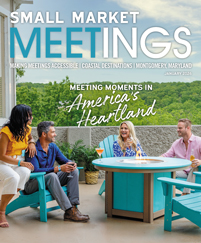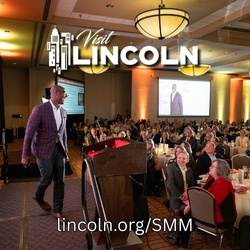A treasure trove of museums and historic sites pepper the state of Indiana, showcasing the history of people from the Native Americans who first called the area home to the European settlers and other groups that have migrated here over the centuries. These five museums offer meeting groups the chance to host events in settings more unique than hotel ballrooms while absorbing a little history at the same time.
Corydon Capitol State Historic Site
Corydon, Indiana
Corydon served as the capital of Indiana when it first became a state in 1816. The city is in the southern portion of the state.
The capitol building was built between 1814 and 1816 and has been perfectly preserved, in part because it has remained in constant use since its founding. It served as the seat of government until 1825, when the state capital moved to Indianapolis. It is well known as the site where Indiana’s first constitution was signed into law. After 1825, the building served as the county courthouse until a new one was built in the 1920s. At that time, there was a push to turn the historic capitol into a museum to tell the story of Indiana’s founding and the men who made it happen. As part of the renovation, the building was restored to its original appearance on the inside.
The historic site also has a governor’s headquarters building, which was purchased for the governor to use while the legislature was in session, as well as the First State Office Building.
The capitol building sits in the middle of a square that can be rented out for large outdoor events. The office building, which was built in 1816, can accommodate 75 guests for a standing reception or 45 for a sit-down event.
Angel Mounds State Historic Site
Evansville, Indiana
Located on the banks of the Ohio River in southwest Indiana, Angel Mounds State Historic Site preserves one of the best precontact Native American sites in North America. Built between A.D. 1000 and 1450, the town was occupied by more than 1,000 people during its heyday. The site stands out because of the large earthen mounds that were built to elevate important buildings.
The historic site comprises 575 acres, and its interpretive center offers a place for visitors to learn about the Native Americans who lived there and the artifacts discovered by archaeologists. The interpretive center is being renovated and is expected to reopen with its first new exhibit in 20 years in November. The old exhibit told the story of the site from an archaeological perspective. The new exhibit is a collaboration with representatives of the local tribes that are descendants of the Mississippian culture that built the mounds.
The renovation will allow groups to better make use of the interpretive center for events. Overlook Hall features a window overlooking the property’s central mound. It can host groups of up to 120 people. A smaller conference room can host more intimate groups. Groups that rent out the entire site for large events can have total access to the village site.
The museum rental includes tables, chairs and A/V equipment. Groups can bring in off-site caterers to serve their event.
Elkhart County Historical Museum
Bristol, Indiana
The Elkhart County Historical Museum in Bristol was founded as the Elkhart County Historical Society in 1896. It moved into its current building in 1968.
The museum strives to tell the stories of the many residents of this county in northern Indiana, not just those of its earliest European settlers. That includes the stories of the native cultures, including the Miami and Potawatomi tribes. The museum’s leaders want to build relationships among all groups, including African Americans, Hispanic and Latino groups in the community and others that aren’t represented by a historical European pioneer focus.
The museum incorporates interactive exhibits whenever possible. Clues Through the Lens, its latest exhibit, uses the museum’s image collection to ask questions of history and to encourage people to think like a detective to better understand the past. A permanent exhibit gives an overview of Elkhart County from its paleo residents up through modern times.
The museum is attached to a gymnasium that was built in 1925. Groups of up to 300 can rent it out for meetings or events. The facility provides tables and chairs, but groups must bring their own A/V equipment and food. No alcohol is allowed. Since the building is historic, it does not have air conditioning and is most often rented out in the colder months of the year. Groups can plan a visit to the museum as part of their facility rental. If the event is outside normal business hours, they will have to make a reservation to include a visit to the museum exhibits.
T.C. Steele State Historic Site
Nashville, Indiana
Theodore Clement “T.C.” Steele was an American Impressionist painter who was best known for his paintings of Indiana’s natural landscapes. Steele was a member of the renowned Hoosier Group and studied at the Royal Academy in Munich, Germany, from 1880 to 1885. Upon his return to Indiana, Steele made his living painting portraits but developed a love of landscape painting through his travels in Southern Indiana.
After his first wife died, he moved with his second wife to Brown County, Indiana, in 1907. They built their home among the rolling hills, calling it the House of the Singing Winds. They built a large studio in 1916 to hold T.C.’s artwork, and his wife planted several gardens around the home and studio and landscaped the surrounding property to help it blend in with the area’s natural beauty.
The property is open to visitors, and groups can take advantage of it for meetings or events. The property’s grounds make a lovely backdrop for weddings or receptions among the gardens or spruce grove. The outdoor spaces can host groups of 50 to 300 guests.
T.C. Steele’s Large Studio was designed to display his work in a way that was consistent with the surrounding landscape. It has a large window on one side overlooking Brown County and is a great indoor venue for groups of up to 50.
The property also has a classroom space with a small kitchen that can host groups of up to 15.
Auburn Cord Duesenberg Automobile Museum
Auburn, Indiana
The Auburn Cord Duesenberg Automobile Museum is celebrating its 50th anniversary this year. It is located in a historic Art Deco building that was constructed in 1930 as the showroom and corporate offices of the Auburn Automobile Company. Visitors can not only enjoy the building’s architecture but also spend time perusing the 120 vehicles in the collection, many of which are on loan from private collections and other museums.
The museum displays cars that were built by Auburn, Cord or Duesenberg; vehicles that were built in Indiana; and prototype vehicles. It also features racing and engineering exhibits.
The facility has three meeting spaces: two smaller rooms that can accommodate team building or corporate retreats and a large event space, Willennar Hall, that can host 816 guests for weddings, large community events or fundraisers. The museum is always open when an event is going on, and groups can explore the different exhibits on their own. Docent-led tours must be arranged in advance. There is a list of preferred caterers, but the museum has everything a group would need to pull off an event, including A/V equipment. The facility has its own liquor license, so if a group would like alcohol service, it can be provided.
The museum hosts the ACD Festival, an annual classic car show and festival, as well as the Gatsby Gala Ball, a 1920s dance.












